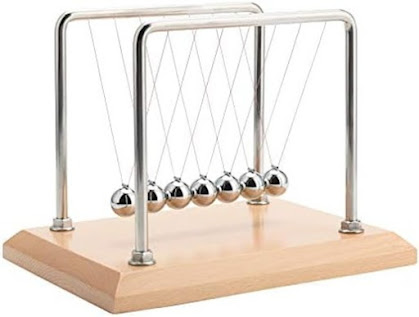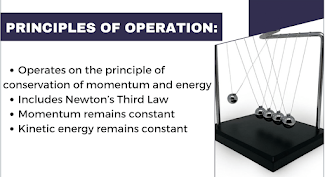Topic:
Group Work
AMNA JALAL
UME HANI ALI
ZEENAT MUJTABA
ZAINAB SHAHID
Abstract:
The Newton's cradle is a
device that demonstrates the conservation of momentum and
the conservation of energy with swinging spheres. When one sphere at
the end is lifted and released, it strikes the
stationary spheres, transmitting a pressure or sonic wave through the
stationary spheres that creates a force that pushes the last sphere
upward. The last sphere swings back and strikes the nearly stationary spheres,
repeating the effect in the opposite direction. The device is named after
17th-century English scientist Sir Issac Newton and designed by
French scientist Edme Mariotte. It is also known as Newton's
pendulum, Newton's balls, Newton's rocker or executive ball
clicker.
History:
The principle demonstrated by the
device, the law of impacts between bodies, was first demonstrated by the French physicist Abbé
Mariotte in the 17th century. His work on the topic was first
presented to the French Academy
of Sciences in
1671; it was published in 1673 as ("Treatise on percussion or shock
of bodies").
Newton acknowledged Mariotte's work,
along with Wren, Wallis and Huygens as the pioneers of experiments on the
collisions of pendulum balls, in his Principia.
Christiaan
Huygens used pendulums to study collisions. His work (On the
Motion of Bodies by Collision) published posthumously in 1703, contains a
version of Newton's first law and
discusses the collision of suspended bodies including two bodies of equal mass
with the motion of the moving body being transferred to the one at rest.
There is much confusion over the
origins of the modern Newton's cradle. Marius J. Morin has been credited as
being the first to name and make this popular executive toy. However, in early 1967, an English
actor, Simon Prebble, coined the name
"Newton's cradle" (now used generically) for the wooden version
manufactured by his company, Scientific Demonstrations Ltd.
Construction:
The largest cradle device in the world was designed by Myth Busters and consisted of five one-ton concrete and steel rebar-filled buoys suspended from a steel truss. The buoys also had a steel plate inserted in between their two-halves to act as a "contact point" for transferring the energy; this cradle device did not function well because concrete is not elastic so most of the energy was lost to a heat build up in the concrete.
Operation:
When one of the end balls ("the
first") is pulled sideways, the attached string makes it follow an upward
arc. When it is let go, it strikes the second ball and comes to nearly a dead
stop. The ball on the opposite side acquires most of the velocity of the first ball and swings in an arc
almost as high as the release height of the first ball. This shows that the last
ball receives most of the energy and momentum of the first ball. The impact produces
a sonic wave that propagates through
the intermediate balls. Any efficiently elastic material such as steel does
this, as long as the kinetic energy is temporarily stored
as potential energy in the compression of the
material rather than being lost as heat. This is similar to bouncing one coin
of a line of touching coins by striking it with another coin, and which happens
even if the first struck coin is constrained by pressing on its center such
that it cannot move.
There are slight movements in all
the balls after the initial strike, but the last ball receives most of the
initial energy from the impact of the first ball. When two (or three) balls are
dropped, the two (or three) balls on the opposite side swing out. Some say that
this behavior demonstrates the conservation of momentum and kinetic energy in
elastic collisions. However, if the colliding balls behave as described above
with the same mass possessing the same
velocity before and after the collisions, then any function of mass and
velocity is conserved in such an event.
Physics Explanation:
Newton's cradle with two balls of equal weight and perfectly efficient elasticity. The left ball is pulled away and let go. Neglecting the energy losses, the left ball strikes the right ball, transferring all the velocity to the right ball. Because they are the same weight, the same velocity indicates all the momentum and energy are also transferred. The kinetic energy, as determined by the velocity, is converted to potential energy as it reaches the same height as the initial ball and the cycle repeats.An idealized Newton's cradle with five balls when there are no energy losses and there is always a small separation between the balls, except for when a pair is colliding Newton's cradle three-ball swing in a five-ball system. The central ball swings without any apparent interruption.
Newton's cradle can be modelled fairly accurately with simple mathematical equations with the assumption that the balls always collide in pairs. If one ball strikes four stationary balls that are already touching, these simple equations can not explain the resulting movements in all five balls, which are not due to friction losses. For example, in a real Newton's cradle the fourth has some movement and the first ball has a slight reverse movement. All the animations in this article show idealized action (simple solution) that only occurs if the balls are not touching initially and only collide in pairs.
Simple solution:
The conservation of
momentum (mass × velocity); p=mv and kinetic energy (1/2 ×
mass × velocity2) KE = ½ mv2 can be used to find the resulting velocities
for two colliding perfectly elastic objects. These two equations are used
to determine the resulting velocities of the two objects. For the case of two
balls constrained to a straight path by the strings in the cradle, the
velocities are a single number instead of a 3D vector for 3D space, so the math
requires only two equations to solve for two unknowns. When the two objects
have the same mass, the solution is simple: the moving object stops relative to
the stationary one and the stationary one picks up all the other's initial
velocity. This assumes perfectly elastic objects, so there is no need to account
for heat and sound energy losses.
Steel does not compress much, but
its elasticity is very efficient, so it does not cause much waste heat.
The simple effect from two same-mass efficiently elastic colliding objects
constrained to a straight path is the basis of the effect seen in the cradle
and gives an approximate solution to all its activities.
For a sequence of same-mass elastic
objects constrained to a straight path, the effect continues to each successive
object. For example, when two balls are dropped to strike three stationary
balls in a cradle, there is an unnoticed but crucial small distance between the
two dropped balls, and the action is as follows: the first moving ball that
strikes the first stationary ball (the second ball striking the third ball)
transfers all of its momentum to the third ball and stops. The third ball then
transfers the momentum to the fourth ball and stops, and then the fourth to the
fifth ball.
Right behind this sequence, the
second moving ball is transferring its momentum to the first moving ball that
just stopped, and the sequence repeats immediately and imperceptibly behind the
first sequence, ejecting the fourth ball right behind the fifth ball with the
same small separation that was between the two initial striking balls. If they
are simply touching when they strike the third ball, precision requires the
more complete solution below.
Effect of different types of balls:
Using different types of material
does not change the action as long as the material is efficiently elastic. The
size of the spheres does not change the results unless the increased weight
exceeds the elastic limit of the material. If the solid balls are too large,
energy is being lost as heat, because the elastic limit increases with the
radius raised to the power, but the energy which had to be absorbed and
released increases as the cube of the radius. Making the contact surfaces
flatter can overcome this to an extent by distributing the compression to a
larger amount of material but it can introduce an alignment problem. Steel is
better than most materials because it allows the simple solution to apply more
often in collisions after the first strike, its elastic range for storing
energy remains good despite the higher energy caused by its weight, and the higher
weight decreases the effect of air resistance.
Uses of Newton's cradle:
Some of the uses of Newton's cradle
include:
Demonstrating conservation of
energy and momentum: Newton's cradle visualizes an elastic collision by
allowing students to see the mass as a number of balls, and the speed as the
height the balls travel. This shows that momentum and energy must be conserved.
Teaching physics
concepts: Newton's cradle can be used to teach concepts such as elastic
and inelastic collisions, gravitational potential energy, and conversion from
potential to kinetic energy.
Entertainment: Newton's cradle can be used for entertainment
purposes by experimenting with the number of balls pulled back, the amount of
energy they start with, and observing the transfer of momentum and energy from
one ball to the other.













No comments:
Post a Comment